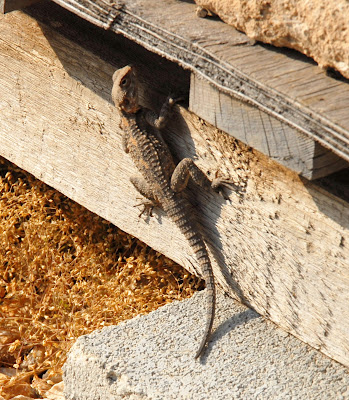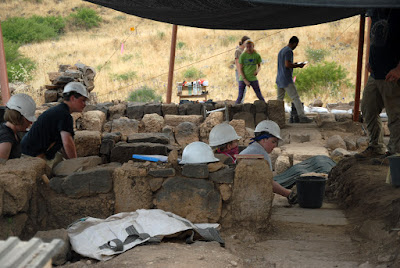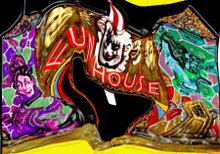The Whole Reason I'm Here
Okay, so on to the work of archaeological excavation. It is a fascinating arduous process. I rise at 4:00 because we have to be at the site by 5:00AM. At that hour I find it hard to remember to bring all my things, trowel, gloves, tape measure etc and most importantly water. We work so early in the morning because the temperature is cooler.
When one arrives at the site the sun has not yet risen.
Fortunately there have been clouds in the morning which keeps things cooler than it might otherwise be. We have also had a breeze, which has kept the many insects at bay.
The first order of the day is to set up the tarps. This shields the workers from the sun and keeps things cooler as well as protecting the site a bit.
The teams are each assigned a "square" which is the area in which they dig. The square is carefully excavated in layers to try and preserve as much information about what was where when as possible.
Each day before digging begins and after it is finished an "elevation"
is taken to erstablish the level of the excavation. When soils change,
architectural elements are found or there is a noticeable change in the
material being found, a new "locus" is declared and a new elevation is
taken. Elevations are taken with surveying equipment. (You can see it (barely) in
the left corner of the picture below.)
For each new type of soil or locus a Munsell number is assigned to designate the color of the earth. Consistency of the soil is also assessed in terms of amounts of clay, gravel, and sand. Below is the book used to determine the color of the locus soil.
Then the digging begins. Here is the square for our team.
You start with pick axes to soften the soil and then go to hoes. Everything in that layer is removed in buckets. Larger stones are put into a rubber stone bucket (seen to the right in the picture below. Our team is working on a boulder that is lodged in the midst of our square. These have to be isolated and then pulled out by brute strength.
As you see, it can be quite a process. If necessary a winch is set up, but this takes time and they try to keep loss of time in the field to a minimum because there is a scheduled closing date, so there is limited time to get as much information as possible.
The site is interesting for other reasons. You can see that it has been a crossroads for more than ancient civilizations!
I saw my first fox on the first day - but could not get a sharp picture. Is anybody surprised?! We see lizards and flying insects and others have found scorpions, but I have not been lucky enough to see one of those yet.
OUr site is located in the North between a cow pasture and a mine field.
It seems like there are intersting things up in the hills of the mine field, but unfortunately they cannot be accessed. We often hear artillery practice by the Israeli army in the distance while we dig. The barbed wire fence in the field of thistles below marks the beginning of the mine field.
Work continues until "second breakfast". (We have eaten peanut butter and jelly sandwiches in the car on the way to the site for first breakfast.) The work is back-breakingly strenuous and so ther is a "tea" break in the field with cookies and also breakfast before we head home for lunch at 12:30.
We have a field kitchen where the meal is prepared and then put on long tables for the chow line.
Then we are all called out of the field and share a quick meal together accompanied by readings of Deep Thoughts by Jack Handey.
Below are some random images of the site.
Our site has one civilization layered on top of another. There are Roman temples and also signs of a small Christian church having been erected nearby. Here you see a cross in a circle carved into a square block (off-center left below.)
The thistles are magnificently beautiful (whether alive or dead).
Work continues after breakfast. Buckets of soil and artifacts (see right wall below) are removed and then taken to sifting stations.
At the sifting station rocks are removed and sand is sifted into wheel barrows (which fill quickly and have to be wheeled off to dumping piles.)
We separate out the glass, bone, ceramics, fresco materials and roof tiles. Occasionally I hear we find coins, but I have not yet seen one. These are bagged and tagged (put in buckets if ceramic and boxes for everything else with locus numbers, so they can be taken back to camp and analyzed. By 12:30 everyone is tired and ready for food.
Even though we have already put in a pretty full day, the work is not over yet. In the afternoon you have to wash your pottery sherds. The group gathers together with buckets of sherds and brushes and cleans the fragments of pots.
Cleaned pottery will then be hung up to dry and analyzed by the specialists.
Archaeology is an amazing field that requires an army of specialists. We have someone specializing in ceramics, an architect, someone that does glass and a couple of people who do coins. You also need geologists, specialists on tesserae and mosaics, draughts"men", text scholars and historians and a whole lot of other people from a variety of fields. By bringing the knowledge of all of these people together you can begin to put together a picture of what was going on and when it was happening. It is truly an amazing field of study.






























No comments:
Post a Comment